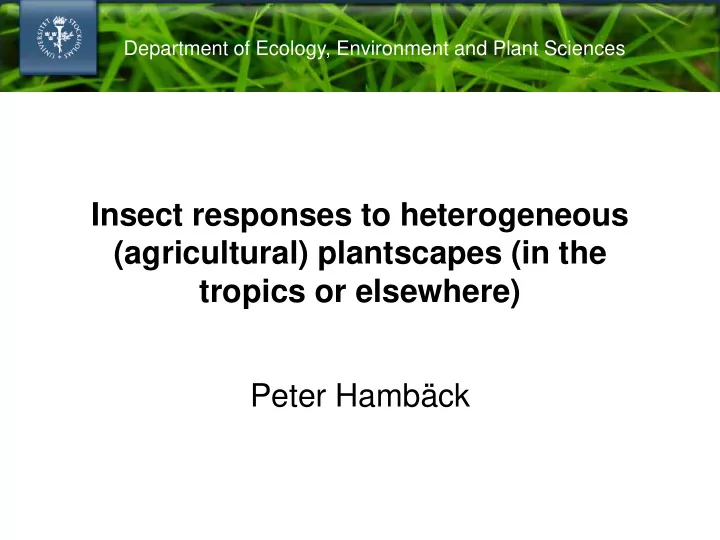

Department of Ecology, Environment and Plant Sciences Insect responses to heterogeneous (agricultural) plantscapes (in the tropics or elsewhere) Peter Hambäck
Local processes
Quantifying the patterns Välimäki & Itämies 2003 Otway et al. 2005 Hambäck et al 2000 40 10 100 # egg per plant 30 Density 1 10 Density 20 1 0.1 10 0.1 0 0.01 100 1000 10000 1 10 100 1000 outside inside Patch size Host plant density shrubs Density-area relationship Density-density relationship Log response ratio DAR-slope DDR-slope LRR
Responses depend on species traits
General responses to heterogeneity 0.5 Response to intercropping (lnRR) 0.0 -0.5 40 40 # egg per plant # egg per plant 30 30 20 20 -1.0 10 10 0 0 outside inside shrubs -1.5 -2.0 -1.0 -0.5 0.0 0.5 1.0 Response to patch size (DAR slope ) 100 Density 10 1 0.1 100 1000 10000 Patch size Hambäck & Andersson unpubl
Andean potato weevils in relation to local and landscape features Parsa et al. (2012) : PLoS ONE 7(5): e36533
Different source sizes Parsa et al. (2012) : PLoS ONE 7(5): e36533
Different source sizes Last Last Last year year year This year This year Last year Last year Parsa et al. (2012) : PLoS ONE 7(5): e36533
Different target size Parsa et al. (2012) : PLoS ONE 7(5): e36533
Dilution effects This Last year year Last year This year This year This year Parsa et al. (2012) : PLoS ONE 7(5): e36533
Different target sizes Parsa et al. (2012) : PLoS ONE 7(5): e36533
Target size effects Number of immigrants This year Last year Patch size This year Ln(density) 1:1 This year Ln(Patch size) Parsa et al. (2012) : PLoS ONE 7(5): e36533
Response to spatial scale Photo: Angela Schwartz Photo: Leonardo Melchionda Photo: Lars Ove Hansen 1000 1 100 10 Density Density Density 100 1 10 0.1 0.1 1 10 100 1000 100 1000 10000 100000 100 1000 10000 Patch size Patch size Patch size Eupteryx (Homoptera) Chiastocheta (Diptera) Parnassius (Lepidoptera) Zabel & Tscharntke 1998 Johannesen & Loeschcke 1996 Välimäki & Itämies 2003
The resource concentration hypothesis Large, homogeneous and dense patches are high resource concentrations and attracts higher insect densities. Density is higher in large patches, for instance, because (Root 1973): Immigration is larger to large patches Emigration is larger from small patches
A modelling framework mortality Local density Emigration (En) Immigration (I) (n) − β − ζ = A ε = iA E I birth dn = − + rn En I dt
A stepwise process Spatial distribution of plants Distribution of information Herbivore perception Probability of locating plants Spatial distribution on herbivores
Insects have their traits
Insects may locate patches in different ways Immigration rate Immigration rate Immigration rate depends on depends on depends on area perimeter diameter e.g. aphids e.g. carabids e.g. lepidopterans
Scaling the number of immigrants Log(immigration rate) 1:1 Log(patch size)
Effect on local density has different scaling Log(immigration rate) Perimeter-to-area ratio Diameter-to-area ratio Log(patch size)
Observed immigration scalings 0.5 Scaling coefficient 0 -0.5 -1 Aphids Beetles Butterflies Moths (N=6) (N=6) (N=31) (N=3)
Including emigration mortality Local density Emigration (En) Immigration (I) (n) − β − ζ = A ε = iA I E birth dn = − + rn En I dt
Translating to density-area relationship β > ζ immigration rate emigration rate Log(density) β = ζ β < ζ Log(patch size)
Observations on DAR slopes 100 Flies 10 Density Moths 1 Butterflies 0.1 100 1000 10000 Beetles Patch size Leaf/planthoppers Aphids -0.6 -0.4 -0.2 0 0.2 0.4 0.6 DAR slope
Observations on DAR slopes Flies Moths Is difference in response due Butterflies to differences in search modality? Beetles Leaf/planthoppers Aphids -0.6 -0.4 -0.2 0 0.2 0.4 0.6 DAR slope
How do olfactory searching insects experience their environment?
Measuring olfactory information Andersson et al. In press
Measuring olfactory information Antennal response (mV 0.004 0.003 0.002 0.001 0.000 0 5 10 15 20 25 30 Time (s)
Quantifying olfactory information fields Antennal response (mV Antennal response (mV 0.0015 0.0015 1m 10m 0.0005 0.0005 -0.0005 -0.0005 0 10 20 30 40 50 60 0 10 20 30 40 50 60 Time (s) Time (s) Antennal response (mV Antennal response (mV 0.0015 0.0015 16m Control 0.0005 0.0005 -0.0005 -0.0005 60 70 80 90 100 110 120 0 10 20 30 40 50 60 Time (s) Time (s)
Odor decay with distance Different patch sizes Different resource densities 0.8 0.6 0.4 4 odor sources 0.2 0 0 20 40 60 80 0.8 0.6 0.4 9 odor sources 0.2 0 0 20 40 60 80 0.8 0.6 0.4 25 odor sources 0.2 0 0 20 40 60 80 Downwind distance (m)
Observations on DDR slopes Beetles (14) 10 10 Flies (7) -1 -1 Aphids (18) Density Density 1 1 Leafhoppers (2) Plant lice (1) Bugs (1) 0.1 0.1 Butterflies (2) Moths (10) 0.01 0.01 1 1 10 10 100 100 1000 1000 -1.5 -1 -0.5 0 0.5 1 1.5 Host plant density Host plant density Noctuidae (3) Plutellidae (3) Pyralidae (3) Sphingidae (1) Coccinellidae (3) Curculionidae (8) Chrysomelidae (3) -1.5 -1 -0.5 0 0.5 1 1.5 Scaling coefficient ( DDR slope ) Andersson et al. 2013. Oikos 122: 1009
Conclusions Environmental constraint Density patterns Search Feedback modality A need for mechanistic studies connecting pattern to process
Acknowledgements Petter Andersson Göran Englund Lia Hemerik Brian lnouye Marjolein Lof Christer Löfstedt Nora Underwood
Recommend
More recommend